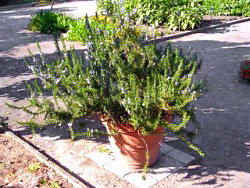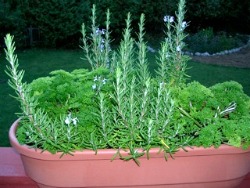
Rosemary is an evergreen, perennial herb that grows well in clay pots. It can get large if protected each winter in cold climates.

In warm climates rosemary makes an attractive, low growing, edible hedge or used to cascade over a garden wall.
Rosemary is one of those Mediterranean herbs with a long and varied history. It has been used to cure a variety of ills, from baldness to gout. It is said to keep evil spirits away and help reform thieves. Rosemary is known as the herb of remembrance and is the symbol of fidelity and love. It's used in weddings and funerals, and, oh yes, you can eat it, too!
Rosmarinus officinalis is the Latin name for rosemary and means "dew of the sea". It's so named for the pretty blue flowers that are on most rosemary varieties and its tendency in the wild to grow near the ocean. In the kitchen, this evergreen shrub has aromatic leaves that can be used in dishes featuring chicken, fish, and pork. It's also is used to make breads, herb butters, and lemonade! I've even taken branches of rosemary and used them as kabob skewers on the grill.
How, when, and wherever you use rosemary, this beautiful herb makes a striking landscape plant and, where it is hardy, can be used as a foundation plant around the house or in a low growing hedge or mixed shrub border.
PlanningRosemary is hardy in USDA zones 7 to 11. With some protection and the right variety selection, you may be able to get it to survive zone 6 winters outdoors. However, if you live in a climate colder than zone 6, you can still enjoy rosemary as more than an annual herb. Rosemary is very suited to pot culture and can be brought indoors in winter and grown as a houseplant. With some care, you can get it to survive for years, even in the North.
There are many varieties of rosemary to try in your garden or container. While most are upright-growing shrubs that can reach 3- to 5-feet tall and wide in warm areas, there are also creeping types, some with yellow-green leaves, and some with white or pink, instead of blue, flowers. All those listed below have blue flowers unless otherwise noted. Try out a few of these in your garden this summer.
'Arp' – Considered one of the hardiest rosemary varieties, 'Arp' has an upright habit and may be overwintered in zone 6 with protection.
'Collingwood Ingram' – A creeping selection that grows well in window boxes and containers, this variety features highly fragrant leaves.
'Golden Rain' – A unique, upright variety that features green leaves with yellow on the edges. It is highly ornamental as well as well as tasty.
'Kenneth's Prostrate' – This fast growing, creeping variety produces flowers in late summer and fall.
'Miss Jessup' – An upright variety that was bred especially for its production of flowers.
'Pine Scented' – This upright bush is known for the pine scent from its leaves. The fine needles make this shrub look like a miniature Christmas tree.
'Spanish' – Also known as 'Majorca', this upright rosemary has unusual pink flowers and thin, needle-like leaves.
'Tuscan Blue' – This early-flowering, upright variety is known for its dense flowering habit.
'White-Flowered' – A unique white-flowered, upright selection that also is known for a heady fragrance.
Planting
Rosemary grows well in window boxes mixed with other herbs such as parsley. If overwintered, you'll have to transplant this rosemary into a bigger pot.
It's best to start with purchased rosemary plants from a garden center or ordered on-line. Rosemary seeds germinate erratically and can be frustrating to get growing. Rosemary requires good air circulation, good water drainage, and plenty of sunshine. Plant rosemary in full sun except in hot climates, where it will benefit from some afternoon shade. It can grow in semi-fertile or even poor soil, but the soil must be well-drained.
Plant purchased seedlings the same depth they were growing in their pots. Space plants 3 feet apart if growing in a row or hedge. If growing in a container, plant in clay pots, to help the soil stay well drained.
CareKeep the soil moist, but not too wet. Fertilize lightly with fish emulsion or compost tea in spring. Rosemary has few problems other than powdery mildew on the needles if grown in an area with poor air circulation. Keep plants well spaced to avoid mildew.
Rosemary can be easily propagated by taking stem cuttings in summer. Snip off a 3-inch piece of one-year old stem, remove the bottom needles, dip the cut end in rooting hormone powder, and stick it in a container filled with moistened potting soil. Cover the pot with a clear plastic bag with holes poked in it. Keep the soil moist. Once you see new growth developing, you’ll know it has rooted. In warm climates you can layer existing plants to create new ones. Bend down a branch and peg it to the ground. Lightly scrape off the needles and some bark on the side of the branch that is in contact with the soil. Dust with a rooting hormone powder and bury that part of the stem in soil. Eventually roots will form, and once new growth is seen on the stem, the new plant can be cut from the mother plant.
In cold climates, overwinter rosemary indoors in pots. Place plants in a sunny window or under grow lights. Keep the day time temperatures around 70 degrees F, while night temperatures should dip into the high 50 degrees F. Let the soil get slightly dry to the touch before watering. Older plants are more drought tolerant than younger plants. Mist plants to keep the humidity high during winter.
To over winter rosemary outdoors in areas where it’s marginally hardy, cover the rosemary plant with shredded bark mulch in fall after a frost. Avoid using materials, such as leaves, that mat down and don't allow good air circulation.
HarvestHarvest rosemary stems, instead of individual leaves, as needed. With a sharp knife or scissors, cut back stems to a main or side branch. Harvest in the morning for best flavor, and periodically cut back rosemary shrubs, even if you're not using the leaves for cooking immediately, to stimulate new, more aromatic growth. Individual stems can be used as kabob skewers for grilling meats and vegetables, imparting food with a wonderful rosemary taste.
Harvest rosemary to dry for winter use by hanging bunches of branches upside down in a well ventilated, cool room. Store the dried needles in glass jars. Remember that rosemary flowers are edible, too, and taste great in salads.
Other rosemary stories:All About Rosemary
Versatile Rosemary
Versatile Rosemary Trees
 Charlie Nardozzi is an award winning, nationally recognized garden writer, speaker, radio, and television personality. He has worked for more than 30 years bringing expert gardening information to home gardeners through radio, television, talks, tours, on-line, and the printed page. Charlie delights in making gardening information simple, easy, fun and accessible to everyone. He's the author of 6 books, has three radio shows in New England and a TV show. He leads Garden Tours around the world and consults with organizations and companies about gardening programs. See more about him at Gardening With Charlie.
Charlie Nardozzi is an award winning, nationally recognized garden writer, speaker, radio, and television personality. He has worked for more than 30 years bringing expert gardening information to home gardeners through radio, television, talks, tours, on-line, and the printed page. Charlie delights in making gardening information simple, easy, fun and accessible to everyone. He's the author of 6 books, has three radio shows in New England and a TV show. He leads Garden Tours around the world and consults with organizations and companies about gardening programs. See more about him at Gardening With Charlie.
 Victory Seed Company has all the seeds you want for your best garden in 2024.
Victory Seed Company has all the seeds you want for your best garden in 2024.
For 25 years, the family-owned Victory Seed Company has provided the highest quality vegetable, herb and flower seeds to families across the country. We are passionate about providing you the best seeds available that give excellent germination, robust plants, and the harvest you want. With a catalog of over a thousand varieties, we have everything, and our prices are the kinds that we'd want to pay. We have hundreds of yesterday's heirloom vegetables, as well as today's award winning hybrid selections. Get to know us by visiting our website and browsing through our online vegetable seed catalog.